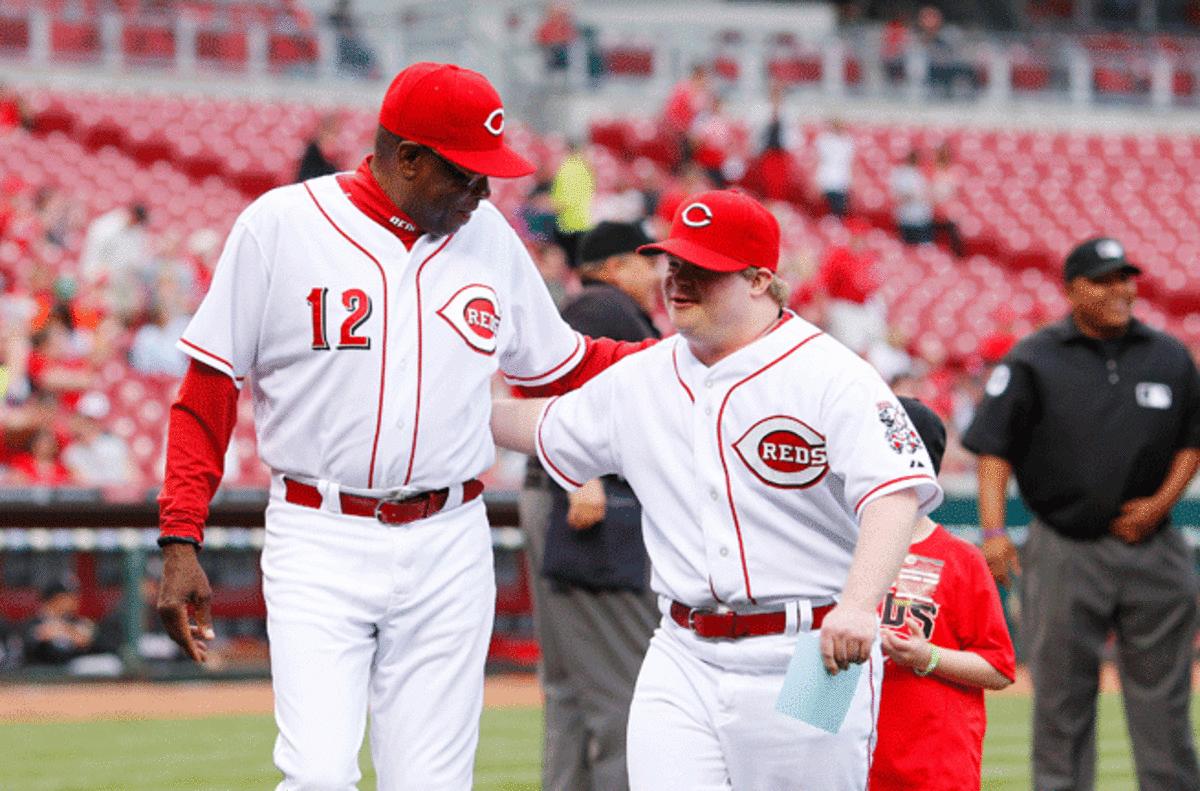Reds batboy with Down Syndrome a great story, but it shouldn't end


Feel good stories are easy. Summon compassion, engage the empathy gear and drive. Nobody doesn't like his or her heart warmed.
Following through is hard. Sticking around after the camera lights dim and the truck is packed takes work. That's where the Cincinnati Reds find themselves now, with their honorary batboy, Teddy Kremer.
You might have seen Kremer on the highlights. In a game a week or so ago, he asked Reds third baseman Todd Frazier to hit a home run. Frazier did just that. Cue Kremer, greeting Frazier at home plate, so completely joyed that he neglected to pick up Frazier's bat. The triumphant pair proceeded to hug in the dugout.
If you didn't see that, maybe you caught Kremer with Speaker of the House John Boehner (R-Ohio). Kremer was Boehner's guest at President Obama's most recent State of the Union address. ESPN has taken note. It is planning an E:60 segment on the life and times of Teddy Kremer.
It has been nearly a year since the 30-year-old Kremer's parents won the silent auction bid at a school fundraiser that led to their son being the Reds batboy for a night. After Cheryl Kremer agreed to pay the necessary $300, she had a question for Reds chief operating officer Phil Castellini:
"Is it OK that Teddy has Down syndrome?''
OK? It has been better than OK for all concerned. The Reds have been gracious and protective, funneling all appearance and interview requests through the Kremers. They've used Kremer as a batboy twice. The publicity for their effort has been incessantly positive.
It has been good for Cheryl and Dave Kremer to see their son doing things no one would have believed possible a year ago, let alone when Teddy was born. In 1983, doctors and counselors still suggested there were "places'' for people "like Teddy'' to live.
It has been good for advocacy groups, who can point to the past year and say, "See?''
And of course, no one has had it better than Kremer himself. He has taken an entire city on the ride of his life. Moist eyes and light hearts, all around.
Now it's time to do better.
Kremer's story can't end here. Worse, it can't continue the same as it is now, with Kremer the 30-year-old man making cameos racking Reds bats, whenever the sentiment strikes. The mascoting of Teddy has to end, before it stops being wonderful and becomes something far less.
These stories have become more nuanced as our society has become more attuned with the lives of our citizens with disabilities. There is a subtle bend in the road, where good and right run head-on into patronizing and exploitive. That curve hasn't been reached. But it's just up there, in the near distance.
The next time Kremer is at Great American Ball Park it should be as an employee of the team.
The thought has crossed Phil Castellini's mind. "He's incredibly capable,'' Castellini says. "He could do all kinds of stuff. I could put him in customer service anywhere in the building, and he'd continue to put smiles on people's faces."
Cheryl Kremer has had the same thought, though she says her gratitude for how the Reds have handled things tempered her urge to ask for anything more. "We don't want to overstay our welcome,'' she says.
That's not the issue. Not if the Reds are sincere in their interest. The child that doctors and nurses said might never read finished the 8th grade, while reading at a 5th grade level. Teddy Kremer went on to graduate from high school, where he was a member of the swim team and was nominated for Prom King.
He has worked several part-time jobs, which have required he master Cincinnati's public transit system. He takes ballroom dancing and plays softball. He's obviously adept at racking bats and raising spirits. He "would be ecstatic,'' Cheryl says, to land meaningful work with the Reds. "It would be really good for him, and for his self esteem.''
Ted Kremer, usher.
Ted Kremer, tour guide.
Goodwill ambassador, ticket scanner. And so on.
His joy is natural. In Cincinnati, it has assumed a life of its own.
"That first game was just me, fulfilling an auction obligation,'' Castellini says. "People sitting on the first base side [above the Reds dugout] could see his beaming face, how animated he was. By the end of the night, the whole stadium was picking up on it.''
Then last week, Frazier pounded a 421-foot homer to centerfield, per Kremer's request. "I started smiling even before I hit home plate,'' Frazier told the Cincinnati Enquirer. "They said he forgot to pick the bat up, so the umpire was yelling at him. It was such a great'' moment. "You can't get mad -- even if you have a terrible day. How can you be mad when you've got a guy like that around?"
He needs to be around more. The joy shouldn't be tethered to batboy cameos.
Jillian Daugherty understands this. For three years my daughter, who also has Down syndrome, was a manager for the Northern Kentucky University men's basketball team. She was never a feel good story. Coach Dave Bezold added Jillian with the expectation that she would work, and grow into the job. He didn't have time for charity.
This worked on a couple fronts: It forced Jillian to work hard, to meet the expectations that any manager would be asked to meet. And it showed everyone connected with the program that she was capable. Jillian wasn't a mascot. To the players she was "J-Dawg'' who got them water and towels, did their laundry and mopped their basketball floor.
This is Kremer's Next. It is the Reds charge. Providing dignity and acceptance would be the best story of all. It is heavy lifting, sure. What great endeavor is not?
Paul Daugherty is a columnist with the Cincinnati Enquirer.
